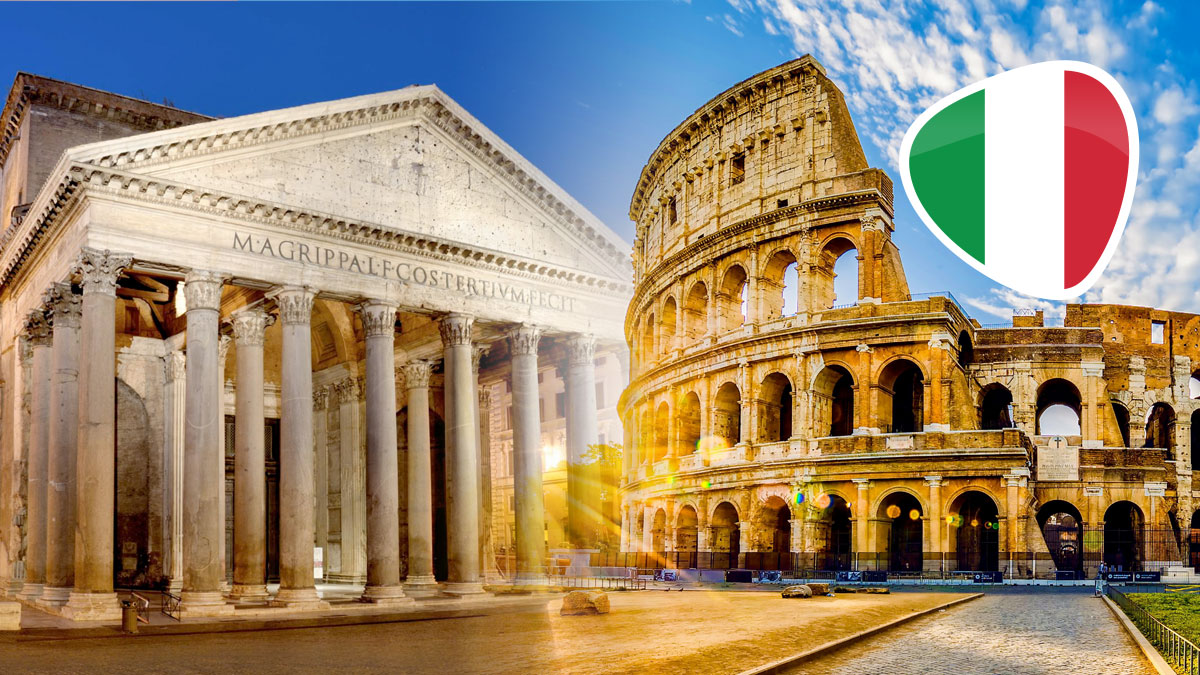Italy is one of the most sought-out tourist destinations on the planet, and it has one of the most intriguing gambling cultures that can be found anywhere.
The roots of gambling in Italy reach back all the way to the Roman Empire when legionnaires would regularly play a sort of backgammon-like game called Ludos Duodecim Scriptorium.
Most casinos in Italy are operated at resorts and hotels and feature a wide variety of table games and slot machines. Italy is definitely on the bucket list of any world traveler, and there are more UNESCO World Heritage sites there than any other country in the world.
Every province of Italy features its own unique culture, cuisine, art, and attractions. On top of that, there are about 38 different gambling facilities in Italy.
Once you’ve quenched your appetite for some gambling in Italy, it’ll be time to experience some truly historically significant sites.
1 – The Colosseum
By far the most iconic structure in all of Italy is the Colosseum. Constructed in the 1st century by Jewish slaves under the order of Emperor Vespasian, the Colosseum is the largest amphitheater in the world.
At the height of its use in Rome, the stadium could seat up to 50,000 spectators and be used for a variety of different events. These included reenactments of famous battles won by the Roman Empire, gladiator contests, and the hunting of animals that were brought in from as far away as Africa.
There were a series of trap doors and secret passageways that would hold the animals which would then be unleashed onto unsuspecting participants. Roman emperors, in order to gain favor with citizens, would pay for and organize events at the Colosseum that were free to the public and gave away food to spectators in the stands.
Some of the games that took place here could last up to 100 days, and even by today’s standards, that’s a lot of propaganda. Some scientists estimate that over the years, as many as a million animals and 400,000 people died within the confines of the Colosseum.
Much of the Colosseum has been destroyed over the past millennia, and most of the damage can be attributed to earthquakes that occurred between 847 to 1231 AD.
Every year, approximately 4 million people from around the globe visit this historic site.
2 – The Pantheon
Also located in Rome, one of the most beloved sites in all of Italy is the 2,000-year-old temple known as the Pantheon.
Built around 120 AD by Emperor Hadrian, this temple stands in the center of the city and is supported by 16 massive columns above which reads an inscription to the original architect, Marcus Agrippa. Agrippa was the close friend and counselor to Emperor Augustus. Emperor Phocas, in 608 AD, gave the Pantheon to Pope Boniface IV who then made it into a church in honor of St Mary.
At the center of its domed-ceiling is a 24-foot diameter opening known as the oculus. The building was designed in a way so that every 21st of April, on Rome’s birthday, the sun comes streaming through this aperture at precisely midday and illuminates the door leading into the Pantheon.
Originally, the outside of the dome was covered in bronze tiles, but these were ripped off the roof’s surface in 663 by the Byzantine Emperor, Constans II.
He wanted them for himself, so he sent them across the Mediterranean to Constantinople, but they never arrived. The ship was ransacked by pirates before it reached its destination.
For over 1,300 years, the Pantheon’s dome was the largest in the world before the architect Brunelleschi built the Duomo in Florence. However, it is still the largest unreinforced dome made of concrete in the world.
The structure was built with varying densities of concrete that decreases near the center of the dome so that it was able to stand on its own.
Each of the granite Corinthian columns at Pantheon’s entrance weighs 60 tons. And each of which was transported from quarries in Egypt and transported across the Mediterranean Sea. This was a monumental task at the time given the journey was approximately 1,500 miles.
Millions of people come to the Pantheon every year, and entrance is free.
3 – Florence, Italy
Known as the birthplace of the Renaissance movement, Florence is considered one of the most historically significant cities in the country and the world.
Some of the most notable artists in history were from Florence, including Michelangelo, Donatello, Raphael, and Dante, including “the father of modern science,” Galileo.
Packed with amazing architecture and shopping experiences, Florence is a city of 1.5 million and the capital of the Tuscan region. The most significant structure in Florence is its main cathedral, the Duomo.
Built in 1436 by the Medici family and designed by famed architect Brunelleschi, this church wasn’t fully completed until the 19th century.
Its Silhouette Dominates the Florence Skyline
Covered in white marble, the reddish and pinkish hue of its exterior dome is truly a breathtaking sight. Another one of the most well-visited sites in Florence is the Ponte Vecchio bridge that spans the Arno River.
Built into the side of this famous bridge is a series of shops, selling jewelry, art, clothes, and products made of world-renowned Tuscan leather. From the river, the shops and houses along the bridge appear to defy gravity by having been built on top of one another.
If you have ever been interested in seeing the world’s most famous statue, Florence has that too! It’s Michaelangelo’s David.
Considered a masterpiece of Renaissance art, it depicts the biblical hero David who was supposedly the first king of Israel. Found in Venice’s Galleria dell’Accademia, Michaelangelo’s David is known for its accurate and detailed depiction of the human form.
4 – The Trevi Fountain
When I visited the Trevi Fountain in Rome, which is supposed to be one of the most famous fountains in the world, it was unlike any kind of fountain that I had ever seen.
It is more like a giant pool that is dominated by massive Baroque statues of Oceanus being led by a chariot and pulled by two horses that have webbed-wings. The entire fountain covers almost an entire city block and reaches a height of 85 feet.
The fountain is the final way station for one of Rome’s earliest aqueducts, and the theme of the fountain is that man, like the gods depicted, have been able to control water and bring abundance and health to the citizens of Rome.
A word of caution, though, don’t drink the water! It’s continuously being recycled, so it’s pretty nasty. And no, you can’t get in the fountain, there is a €500 fine for doing so.
But yes, you can throw coins into the fountain and make a wish. The tradition that has been going back centuries is to toss three coins into its waters. “Trevi” stands for the number three.
Conclusion
There are plenty of other awesome things to do in Italy. What are some of your favorites? Let me know what you think in the comments.
Michael Stevens
Michael Stevens has been researching and writing topics involving the gambling industry for well over a decade now and is considered an expert on all things casino and sports betting. Michael has been writing for GamblingSites.org since early 2016. …



